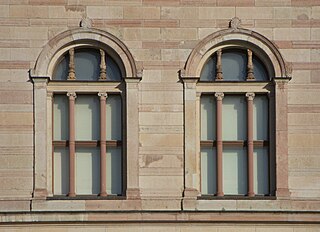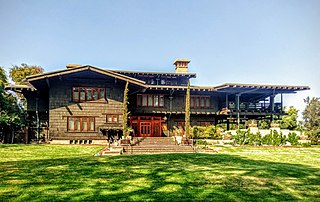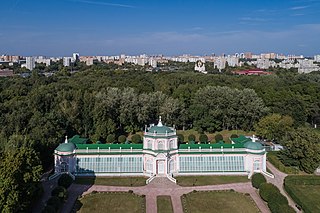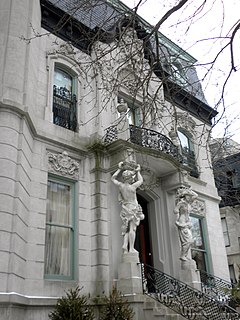
A wall is a structure that defines an area, carries a load; provides security, shelter, or soundproofing; or is decorative. There are many kinds of walls, including:

A window is an opening in a wall, door, roof or vehicle that allows the passage of light, sound, and sometimes air. Modern windows are usually glazed or covered in some other transparent or translucent material, a sash set in a frame in the opening; the sash and frame are also referred to as a window. Many glazed windows may be opened, to allow ventilation, or closed, to exclude inclement weather. Windows often have a latch or similar mechanism to lock the window shut or to hold it open by various amounts.

The Gamble House, also known as the David B. Gamble House, is an iconic American Craftsman home in Pasadena, California, designed by the architectural firm Greene and Greene. Constructed in 1908–09 as a home for David B. Gamble of the Procter & Gamble company, it is today a National Historic Landmark, a California Historical Landmark, and open to the public for tours and events.

The Avery Coonley House, also known as the Coonley House or Coonley Estate was designed by architect Frank Lloyd Wright. Constructed 1908-12, this is a residential estate of several buildings built on the banks of the Des Plaines River in Riverside, Illinois, a suburb of Chicago. It is itself a National Historic Landmark and is included in another National Historic Landmark, the Riverside Historic District.

An orangery or orangerie was a room or a dedicated building on the grounds of fashionable residences from the 17th to the 19th centuries where orange and other fruit trees were protected during the winter, as a very large form of greenhouse or conservatory.

American colonial architecture includes several building design styles associated with the colonial period of the United States, including First Period English (late-medieval), French Colonial, Spanish Colonial, Dutch Colonial, and Georgian. These styles are associated with the houses, churches and government buildings of the period from about 1600 through the 19th century.

Ranch is a domestic architectural style originating in the United States. The ranch-style house is noted for its long, close-to-the-ground profile, and wide open layout. The house style fused modernist ideas and styles with notions of the American Western period of wide open spaces to create a very informal and casual living style. While the original style of the ranch was informal and basic in design, starting around the early 1960s, many ranch-style houses constructed in the United States were increasingly built with more dramatic features like varying roof lines, cathedral ceilings, sunken living rooms, and extensive landscaping and grounds.

Hardwick Hall, in Derbyshire, is an architecturally significant Elizabethan country house in England, a leading example of the Elizabethan prodigy house. Built between 1590 and 1597 for the formidable Bess of Hardwick, it was designed by the architect Robert Smythson, an exponent of the Renaissance style of architecture. Hardwick Hall is one of the earliest examples of the English interpretation of this style, which came into fashion having slowly spread from Florence. Its arrival in Britain coincided with the period when it was no longer necessary or legal to fortify a domestic dwelling. Ownership of the house was transferred to the National Trust in 1959. It is fully open to the public and received 285,379 visitors in 2018.

The Pacific lodge style of architecture is based loosely on vague notions of cedar lodges and log cabin dwellings of early inhabitants of the Pacific Northwest region of the United States and Canada. This style can be seen in historic National Park hotels, such as the Lake Quinault Lodge, and in the houses of some wealthier Seattleites of the timber baron era. However, most early Seattleites preferred to mimic the accepted styles of the East; to this day, historical pastiches remain more popular throughout the region.

Australian residential architectural styles have evolved significantly over time, from the early days of structures made from relatively cheap and imported corrugated iron to more sophisticated styles borrowed from other countries, such as the Victorian style from the United Kingdom, the Georgian style from North America and Europe and the Californian bungalow from the United States. A common feature of the Australian home is the use of fencing in front gardens, also common in both the UK and the US.

A bottle wall is a wall made out of glass or plastic bottles and binding material.

The Francis J. Dewes House is a house located at 503 West Wrightwood Avenue in Chicago, Illinois, United States. The house was built in 1896 by Adolph Cudell and Arthur Hercz for brewer Francis J. Dewes. It was designated a Chicago Landmark on June 12, 1974. It was added to the National Register of Historic Places on August 14, 1973

The Munster Mansion, is an exterior set located at Universal Studios. It is most famous for its use in the 1964–1966 sitcom The Munsters, but has appeared in several other productions, both before and after.

Architecture of Tibet contains Chinese and Indian influences but has many unique features brought about by its adaptation to the cold, generally arid, high-altitude climate of the Tibetan plateau. Buildings are generally made from locally available construction materials, and are often embellished with symbols of Tibetan Buddhism. For example, private homes often have Buddhist prayer flags flying from the rooftop.

The Bachman Wilson House, built in and originally located in Millstone, in Somerset County, New Jersey, United States, was originally designed by Frank Lloyd Wright in 1954 for Abraham Wilson and his first wife, Gloria Bachman. Ms. Bachman's brother, Marvin, had studied with Wright at Taliesin West, his home and studio in Scottsdale, Arizona. In 2014 the house was acquired by the Crystal Bridges Museum of American Art in Bentonville, Arkansas and has been relocated in its entirety to the museum's campus.

The Seamour and Gerte Shavin House is a Frank Lloyd Wright designed Usonian home in Chattanooga, Tennessee. The house was added to the National Register of Historic Places in 1993.

The Thomas Alexander Burningham House at 2849 Pali Highway in Honolulu, Hawaiʻi, built in 1910, is a good example of the earliest American Craftsman bungalow homes in the city. Its flaired hip roof and stone-and-stucco siding differentiate it from the many gabled, and often half-timbered, bungalows built during the 1920s. The architect was Thomas Gill, who designed the Oahu Country Club building and many residences in Honolulu between 1899 and 1941. The house was listed in the National Register of Historic Places in 1993.

The architecture of Madagascar is unique in Africa, bearing strong resemblance to the construction norms and methods of Southern Borneo from which the earliest inhabitants of Madagascar are believed to have immigrated. Throughout Madagascar and the Kalimantan region of Borneo, most traditional houses follow a rectangular rather than round form, and feature a steeply sloped, peaked roof supported by a central pillar.

Earl A. Young was an American architectural designer, realtor, and insurance agent. Over a span of 52 years, he designed and built 31 structures in Charlevoix, Michigan but was never a registered architect. He worked mostly in stone, using limestone, fieldstone, and boulders he found throughout Northern Michigan. The homes are commonly referred to as gnome homes, mushroom houses, or Hobbit houses. His door, window, roof, and fireplace designs were distinct because of his use of curved lines. Young's goal was to show that a small stone house could be as impressive as a castle. Young also helped make Charlevoix the busy, summer resort town that it is today.

The Kohler Riverbend Estate is an historic property located in Kohler, Wisconsin. It was built in 1922–1923 By Walter J. Kohler, Sr., then governor of Wisconsin and president of the Kohler Company. It was reported to cost in excess of $1,000,000 to construct.




















